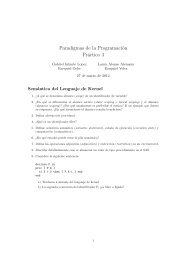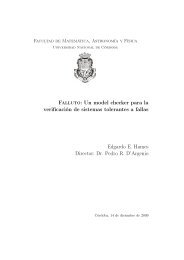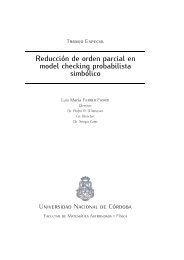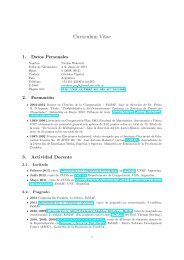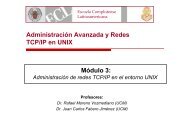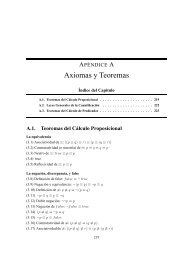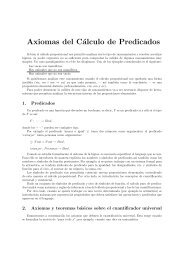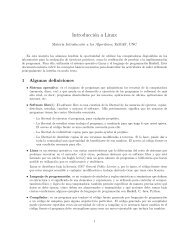Programación Concurrente Examen para la casa - cs@famaf
Programación Concurrente Examen para la casa - cs@famaf
Programación Concurrente Examen para la casa - cs@famaf
You also want an ePaper? Increase the reach of your titles
YUMPU automatically turns print PDFs into web optimized ePapers that Google loves.
<strong>Programación</strong> <strong>Concurrente</strong><strong>Examen</strong> <strong>para</strong> <strong>la</strong> <strong>casa</strong>J. B<strong>la</strong>nco, N. Wolovick11 de julio de 20031. [5, ej.24]a) Para el siguiente multiprograma de N componentes, con 2 ≤ N, demuestre que el número decomponentes ejecutando los fragmentos S es a lo más N −1.Pre: trueComp.p: ∗ [ v := p; if v ≠ p → skip fi; S.p]b) Demuestre que <strong>la</strong> misma propiedad vale en el siguiente multiprograma:Pre: 〈∀q :: ¬x.q〉Comp.p: ∗ [ x.p := true; if 〈∃q : q ≠ p : ¬x.q〉 → skip fi; S.p; x.p := false]c) Explique si <strong>la</strong> situación se modifica cuando cambiamos <strong>la</strong>s componentes a 1 :Pre: 〈∀q :: ¬x.q〉Comp.p: ∗ [ x.p := true; v := p; if v ≠ p ∨ 〈∃q : q ≠ p : ¬x.q〉 → skip fi; S.p; x.p := false]2. [5, ej.32] Elimine <strong>la</strong>s multiasignaciones utilizando Fortalecimiento de Guarda.1 <strong>la</strong> atomicidad es línea a línea.Pre: x ∧ ¬y ∧ ¬zA: ∗[if x → skip fi;x, y := false, true]B: ∗[if y → skip fi;y, z := false, true]C: ∗[if z → skip fi;z, x := false, true]1
P re : n = 0 ∧ p 0 ≠ p 1P 0 : s 0 := false;do ¬ s 0 →〈a 0 := n; lr := p 0 〉;a 0 := a 0 + 1;〈 if lr = p 0 → s 0 , n := true, a 0✷ lr ≠ p 0 → s 0 := falsefi〉odP ost : n = 2P 1 : s 1 := false;do ¬ s 1 →〈a 1 := n; lr := p 1 〉;a 1 := a 1 + 1;〈 if lr = p 1 → s 1 , n := true, a 1✷ lr ≠ p 1 → s 1 := falsefi〉odNotar que si demostramos este programa estamos estableciendo condiciones necesarias <strong>para</strong> <strong>la</strong> equivalenciaentre los P i y 〈n := n + 1〉Como ejercicio complementario escriba test-and-set en nuestro formalismo y realice alguna demostraciónque muestre que son intercambiables en el contexto de un multiprograma, como por ejemplo elproblema de <strong>la</strong> sección crítica.Referencias[1] Gregory R. Andrews, Concurrent Programming: principles and practice, Benjamin Cummings, 1991[2] Gregory Andrews, Foundations of Multithreaded, Parallel, and Distributed Programming, Addison Wesley,2000[3] P. A. Bernstein and V. Hadzi<strong>la</strong>cos and N. Goodman, Concurrency Control and Recovery in DatabaseSystems, Addison-Wesley, Reading, Massachussetts, 1987.[4] Edsger W. Dijkstra, A Tutorial on the Split Binary Semaphore, EWD703, 1979[5] W.H.J. Feijen and A.J.M. van Gasteren, On a Method of MultiProgramming, Monographs in ComputerScience, Springer, 1999[6] Jensen E. and Hagensen G. and Broughton J. A new approach to exclusive data access in shared memorymultiprocessors, Technical Report UCRL-97663, Lawrence Livermore National Laboratory, Nov 1987.[7] John L. Hennessy and David Goldberg and David A. Patterson, Computer Architecture: A QuantitativeApproach, Morgan Kaufmann, 2nd Edition, 1996[8] Rob Hoogerwoord, Semaphores, RH86[9] Rob Hoogerwoord, Two Applications of the Split Binary Semaphore, RH221[10] F. Schneider, On Concurrent Programming, Graduate Texts in Computer Science, Springer, 19973




